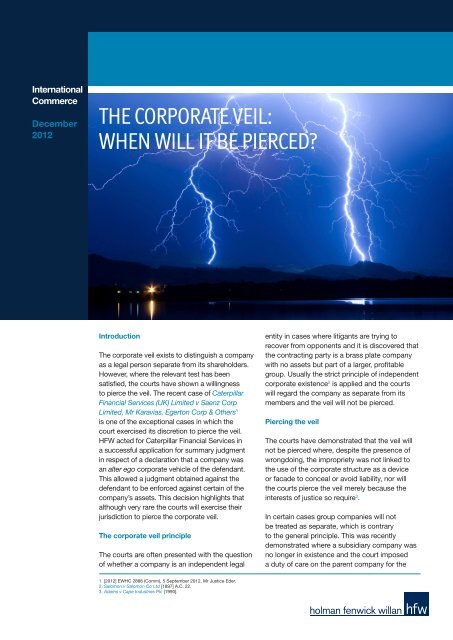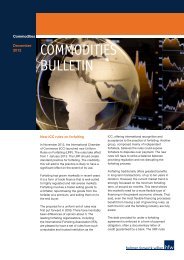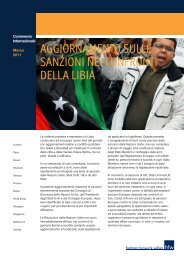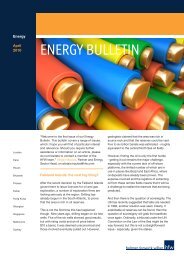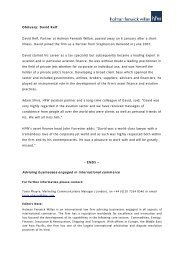THE CORPORATE VEIL: WHEN WILL IT BE PIERCED? - HFW
THE CORPORATE VEIL: WHEN WILL IT BE PIERCED? - HFW
THE CORPORATE VEIL: WHEN WILL IT BE PIERCED? - HFW
You also want an ePaper? Increase the reach of your titles
YUMPU automatically turns print PDFs into web optimized ePapers that Google loves.
International<br />
Commerce<br />
December<br />
2012<br />
<strong>THE</strong> <strong>CORPORATE</strong> <strong>VEIL</strong>:<br />
<strong>WHEN</strong> <strong>WILL</strong> <strong>IT</strong> <strong>BE</strong> <strong>PIERCED</strong><br />
Introduction<br />
The corporate veil exists to distinguish a company<br />
as a legal person separate from its shareholders.<br />
However, where the relevant test has been<br />
satisfied, the courts have shown a willingness<br />
to pierce the veil. The recent case of Caterpillar<br />
Financial Services (UK) Limited v Saenz Corp<br />
Limited, Mr Karavias, Egerton Corp & Others 1<br />
is one of the exceptional cases in which the<br />
court exercised its discretion to pierce the veil.<br />
<strong>HFW</strong> acted for Caterpillar Financial Services in<br />
a successful application for summary judgment<br />
in respect of a declaration that a company was<br />
an alter ego corporate vehicle of the defendant.<br />
This allowed a judgment obtained against the<br />
defendant to be enforced against certain of the<br />
company’s assets. This decision highlights that<br />
although very rare the courts will exercise their<br />
jurisdiction to pierce the corporate veil.<br />
The corporate veil principle<br />
The courts are often presented with the question<br />
of whether a company is an independent legal<br />
entity in cases where litigants are trying to<br />
recover from opponents and it is discovered that<br />
the contracting party is a brass plate company<br />
with no assets but part of a larger, profitable<br />
group. Usually the strict principle of independent<br />
corporate existence 2 is applied and the courts<br />
will regard the company as separate from its<br />
members and the veil will not be pierced.<br />
Piercing the veil<br />
The courts have demonstrated that the veil will<br />
not be pierced where, despite the presence of<br />
wrongdoing, the impropriety was not linked to<br />
the use of the corporate structure as a device<br />
or facade to conceal or avoid liability, nor will<br />
the courts pierce the veil merely because the<br />
interests of justice so require 3 .<br />
In certain cases group companies will not<br />
be treated as separate, which is contrary<br />
to the general principle. This was recently<br />
demonstrated where a subsidiary company was<br />
no longer in existence and the court imposed<br />
a duty of care on the parent company for the<br />
1. [2012] EWHC 2888 (Comm), 5 September 2012, Mr Justice Eder.<br />
2. Salomon v Salomon Co Ltd [1897] A.C. 22.<br />
3. Adams v Cape Industries Plc [1990].
health and safety of the employees of<br />
its subsidiary 4 .<br />
Although it is very rare that piercing<br />
of the corporate veil is allowed,<br />
there have been sporadic attempts<br />
by litigants to do so, such as in a<br />
recent Court of Appeal case 5 , which<br />
is currently being appealed in the<br />
Supreme Court, in which the claimant<br />
bank had provided US$225 million<br />
under a facility agreement. The funds<br />
were used by the Russian borrower,<br />
a company, to facilitate acquisitions<br />
from the first defendant which was<br />
a British Virgin Islands company,<br />
owned and operated from Russia. The<br />
borrower subsequently defaulted on<br />
the loan. The claimant was unable to<br />
recover the loan by way of the security<br />
provided and alleged that fraudulent<br />
misrepresentation by the first<br />
defendant induced it to enter into the<br />
facility agreement and that the other<br />
defendants were jointly liable. Having<br />
obtained permission to serve out<br />
of the jurisdiction, the claimant was<br />
granted a worldwide freezing order<br />
against the fourth defendant, which<br />
the claimant alleged controlled the first<br />
and second defendants. The claimant<br />
made an application to amend its<br />
particulars of claim to incorporate<br />
a contractual claim and argued that<br />
the corporate veil should be pierced<br />
so that the defendants could be<br />
held jointly and severally liable with<br />
the borrower on the basis that they<br />
controlled the actions of the borrower<br />
and they had used the borrower as a<br />
device to conceal their impropriety.<br />
The Court of Appeal decided that it<br />
would be contrary to principle and<br />
authority and therefore not appropriate<br />
to pierce the corporate veil to effect<br />
a contractual claim from the claimant<br />
against those alleged to be controlling<br />
the defendant companies, where<br />
those being pursued were not a party<br />
to that contract.<br />
Caterpillar Financial Services (UK)<br />
Limited v Saenz Corporation Ltd<br />
Caterpillar Financial Services (UK)<br />
Limited (the Claimant) advanced loans<br />
to the first and second defendant<br />
companies for the purpose of the<br />
acquisition and construction of<br />
two yachts. The first and second<br />
defendants defaulted under the loan<br />
agreements. The Claimant made<br />
demands on the first and second<br />
defendants and subsequently<br />
terminated the loan agreements.<br />
Demands were also made on each of<br />
the guarantors of the loans, the third<br />
to ninth defendants.<br />
The defendants are, for the most<br />
part, connected to the first and<br />
second defendant companies, as<br />
well as to the third defendant who is<br />
the controlling mind of all corporate<br />
defendants and also one of the<br />
guarantors. The fourth defendant<br />
company entered into a guarantee<br />
and indemnity in favour of the<br />
Claimant in respect of the loans<br />
advanced. The fifth, sixth and seventh<br />
defendant companies, each provided<br />
guarantees or security to the Claimant<br />
in respect of the loans. The eighth and<br />
ninth defendants, individuals, both<br />
provided guarantees in respect of the<br />
loan to the second defendant.<br />
The tenth to sixteenth defendants<br />
are alter ego corporate vehicles of<br />
the third defendant, who directs<br />
and controls the actions of the<br />
companies.<br />
The Claimant obtained a judgment<br />
against the third defendant (the<br />
Guarantor), in the hope that it could<br />
be enforced against a residential<br />
property (the Property) declared by<br />
the Guarantor as one of his assets<br />
prior to the loan being advanced.<br />
Throughout the proceedings<br />
the Guarantor had asserted that<br />
the Property was owned by the<br />
fourteenth defendant (the Company)<br />
and that he had no beneficial interest<br />
in it. In the Claimant’s application,<br />
it maintained that, had it been<br />
presented with these facts, it would<br />
not have considered advancing the<br />
loans without sufficient security from<br />
the Company, which would allow the<br />
Claimant to pursue the Company and<br />
ultimately enforce a judgment against<br />
the Property in the event of default.<br />
The Claimant made an application for<br />
summary judgment for a declaration<br />
that Company was the alter ego<br />
corporate vehicle for the Guarantor<br />
and that the corporate veil should<br />
be pierced to allow the judgment<br />
obtained against him to be enforced<br />
against any or all assets belonging to<br />
the Company.<br />
The decision in Caterpillar Financial<br />
Services (UK) Limited v Saenz<br />
Corporation Ltd<br />
The relevant tests<br />
The relevant tests that must be<br />
met before the corporate veil may<br />
be pierced 6 and which have been<br />
applied by the courts 7 , can be<br />
summarised as follows:<br />
• Ownership and control of a<br />
company are not sufficient in<br />
themselves to allow the veil to be<br />
pierced.<br />
• Nor can the veil be pierced, where<br />
there is no unconnected third<br />
party, purely on the basis that to<br />
4. Chandler v Cape Plc [2012]<br />
5. VTB Capital Plc v Nutritek International Corp and others<br />
[2012]<br />
6. Hayshem v Shayif & Anor [2008]<br />
7. VTB Capital Plc v Nutritek International Corp and others<br />
[2012] and Caterpillar Financial Services (UK) Limited v<br />
Saenz Corp Limited<br />
02 International Commerce
do so would be in the interests of<br />
justice.<br />
• There must be evidence of<br />
impropriety; however impropriety<br />
alone is insufficient to pierce the<br />
veil. It must be further evidenced<br />
that the impropriety is linked to<br />
avoidance or concealment of a<br />
liability through the use of the<br />
company structure.<br />
• For the court to pierce the veil<br />
the wrongdoer’s intentions may<br />
be considered, but in any case<br />
it must be shown that they<br />
controlled the company and used<br />
it as a facade to conceal their<br />
wrongdoing.<br />
• Whether or not the company<br />
was incorporated with deceptive<br />
intent, the courts will want to<br />
see that it was being used as a<br />
facade at the time of the relevant<br />
transaction(s) and a remedy will<br />
only be provided in respect of the<br />
particular wrong that has been<br />
committed.<br />
• In order to show that a corporate<br />
structure has been used as a<br />
device to conceal impropriety, the<br />
impropriety must first be identified<br />
to the court.<br />
Applying the test<br />
A number of documents, including<br />
those that confirmed that the<br />
Guarantor was receiving bank<br />
documents on behalf of the Company,<br />
showed that the Guarantor was<br />
controlling and directing the actions of<br />
the Company. The first requirement of<br />
control was satisfied on this basis.<br />
It was evidenced that the first<br />
defendant was residing at the<br />
Property and using the address for the<br />
registration of and correspondence<br />
for a number of other companies. In<br />
addition, the Guarantor was trying<br />
to sell the Property at the time of the<br />
freezing injunction application. The<br />
Judge took the view that although<br />
these matters may well be correct<br />
they did not go to the satisfaction of<br />
the fifth principle.<br />
One of the most persuasive factors<br />
considered by Mr Justice Eder when<br />
considering the fifth principle was<br />
that the documentary evidence<br />
showed the Guarantor to be the<br />
ultimate owner and controller of the<br />
Company. The documents included a<br />
letter that the Guarantor had written<br />
to the Claimant prior to the funds<br />
being advanced attaching a net worth<br />
statement from a Greek certified<br />
public accountant that showed one of<br />
the Guarantor’s assets as a “residence<br />
in Fulham, 3,500,000 USD”. A further<br />
net worth statement provided by the<br />
same accountant 16 months later also<br />
identified the Guarantor’s assets to<br />
include a “residence in Fulham” with<br />
a current value of US$3.2 million. The<br />
Judge accepted that the reference<br />
to a “residence in Fulham” was a<br />
reference to the Property which the<br />
Guarantor asserted that he did not<br />
own at the time of the summary<br />
judgment hearing nor at the relevant<br />
period. In light of the documentary<br />
evidence the Judge decided that the<br />
assertions of the Guarantor were not<br />
credible. The Judge went on to say<br />
that “exceptionally...this is a case<br />
where there are no contemporaneous<br />
documents whatsoever to support the<br />
assertions made by [the Guarantor],<br />
whereas the contemporaneous<br />
documents which emanate from the<br />
[the Guarantor] himself are completely<br />
to the contrary...”.<br />
Mr Justice Eder emphasised that at<br />
the time the loan agreements were<br />
entered into, the Guarantor had told<br />
the Claimant that the Property was<br />
his asset and no mention of the<br />
Company had been made nor had<br />
the third defendant indicated that his<br />
interest in the Property was by way<br />
of a shareholding in the Company.<br />
This, according to Mr Justice Eder’s<br />
judgment, satisfied the fifth principle.<br />
Mr Justice Eder said that “the court<br />
will only pierce the veil so far as is<br />
necessary to provide a remedy for<br />
the particular wrong which those<br />
controlling the company have done.<br />
Here it seems to me that the particular<br />
wrong which [the Guarantor] has<br />
done, is that he has mis-used the<br />
company as a device, in effect, or<br />
is now seeking to do that.” On this<br />
basis Mr Justice Eder found that the<br />
Claimant was entitled to a declaration<br />
that it could lift the corporate veil as<br />
far as the Property was concerned<br />
and that any judgment against the<br />
Guarantor could be enforced against<br />
the Property.<br />
The resilience of the corporate veil<br />
Where litigants can show that the<br />
relevant test is satisfied, the courts will<br />
allow them to obtain judgment against<br />
assets that were intentionally placed<br />
out of their reach. However these<br />
cases are and will remain exceptional.<br />
Shipowners frequently and legitimately<br />
structure their group companies by<br />
incorporating single purpose vehicle<br />
companies as vessel-owning entities.<br />
Owners have historically relied on<br />
this structure to provide themselves<br />
with the security that a corporate<br />
veil exists to protect assets owned<br />
by other entities in the event that<br />
unjust attempts are made to pierce<br />
International Commerce 03
it. Only where it can be proved that<br />
the corporate structure is being used<br />
to conceal or avoid a liability will the<br />
protection ordinarily provided by the<br />
corporate veil be at risk.<br />
For more information, please contact,<br />
Paul Dean, Partner, on +44 (0)20 7264<br />
8363 paul.dean@hfw.com, or<br />
Matthew Davey, Associate, on<br />
+44 (0)20 7264 8571 or<br />
matthew.davey@hfw.com, or your usual<br />
<strong>HFW</strong> contact. Assisted by Trainee<br />
Nicola Arthur.<br />
Lawyers for international commerce hfw.com<br />
HOLMAN FENWICK <strong>WILL</strong>AN LLP<br />
Friary Court, 65 Crutched Friars<br />
London EC3N 2AE<br />
United Kingdom<br />
T: +44 (0)20 7264 8000<br />
F: +44 (0)20 7264 8888<br />
© 2012 Holman Fenwick Willan LLP. All rights reserved<br />
Whilst every care has been taken to ensure the accuracy of this information at the time of publication, the information is intended as guidance only. It should not be<br />
considered as legal advice.<br />
Holman Fenwick Willan LLP is the Data Controller for any data that it holds about you. To correct your personal details or change your mailing preferences please<br />
contact Craig Martin on +44 (0)20 7264 8109 or email craig.martin@hfw.com


